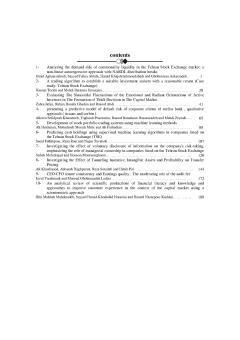Analyzing the demand side of commonality liquidity in the Tehran Stock Exchange market: a non-linear autoregressive approach with NARDL distribution breaks.
Subject Areas : Stock Exchange
Omid Aghaei meybodi
1
,
sayyed yahya Abtahi
2
*
,
hamid khajeh mahmoodabadi
3
,
gholamreza Askarzadeh
4
![]()
1 - Department of Financial Management, Yazd Branch, Islamic Azad University, Yazd, Iran
2 - Department of Financial Management, Yazd Branch, Islamic Azad University, Yazd, Iran
3 - Department of Financial Management, Yazd Branch, Islamic Azad University, Yazd, Iran
4 - Department of Financial Management, Yazd Branch, Islamic Azad University, Yazd, Iran
Keywords: Commonality liquidity, market rate of return, autoregressive method with distributive breaks,
Abstract :
In the last few decades, market participants have given considerable attention to the of liquidity in financial markets. Commonality liquidity and shared movements in transaction costs associated with such a phenomenon have significant consequences in the microstructure of the market. The analysis and identification of such commonalities enables the investor and the policy maker to discover the evidence related to inventory risk and asymmetric information in increasing the liquidity of the stock market. From the non-linear autoregression method with NARDL distribution breaks between the seasonal periods of 2008:01 to 2020:12. The asymmetric long-term results show a negative and significant relationship between the positive rate of return shock and Commonality liquidity and a positive and significant relationship between the negative market return shock and commonality liquidity. The variables of monthly investment by institutional investors, commonality liquidity and exchange rate of return have a positive and significant relationship with commonality liquidity. Export logarithm has a negative and significant relationship with, uncommonality liquidity.
_|1) زارع استحريجي، مجيد. (1381). بررسي عوامل موثر بر قابليت نقد شوندگي سهام در بورس اوراق بهادار تهران. پايان نامه كارشناسي ارشد، دانشكده مديريت، دانشگاه امام صادق(ع).
2) مهرانی، ساسان، رساییان، امیر. (1388)، بررسی رابطه¬ی بین معیارهای نقدشوندگی سهام و بازده سالانهی سهام در بورس اوراق بهادار تهران، مجله پیشرفت¬های حسابداری، (1)1، 217-230.
3) قالیباف اصل، حسن، اقبالی، الهام. (1392). بررسی صرف نقدشوندگی و مدل دو عاملی بازار و نقدشوندگی در بورس اوراق بهادار تهران. مطالعات کمی در مدیریت، (15) 4، 23-1.
4) مقدمی جو، اسماعیل. (1400). بررسی عوامل موثر بر نقدشوندگی قیمت سهام و تاثیر آن بر بازده شرکتهای فعال در بورس اوراق بهادار تهران. پژوهش¬های کاربردی در مدیریت و حسابداری، 22، 120-134.
5) فلاح زاده ابرقویی، احمد، تفتیان، اکرم، حیرانی، فروغ. (1397). بررسی رابطه بین نقدشوندگی سهام و همزمانی قیمت سهام با استفاده از سیستم معادلات همزمان در شرکتهای پذیرفتهشده در بورس اوراق بهادار تهران. مجله دانش سرمایه¬گذاری، (27) 7، 276-257.
6) یحیی¬زاده فر، محمد، شمس، شهاب الدین، لاریمی، سید جعفر. (1389). بررسی رابطه نقدشوندگی با بازده سهام در بورس اوراق بهادار تهران. تحقیقات مالی، (29) 12، 128-11.
7) Amihud, Y. (2002). Illiquidity and stock returns: cross-section and time-series effects. Journal of financial markets, 5(1), 31-56.
8) Bai, M., & Qin, Y. (2010). Who are driving commonality in liquidity?. Global Economy and Finance Journal, 3(1), 61-77.
9) Brockman, P., & Chung, D. Y. (2006). Index inclusion and commonality in liquidity: Evidence from the Stock Exchange of Hong Kong. International Review of Financial Analysis, 15(4-5), 291-305.
10) Brockman, P., Chung, D. Y., & Pérignon, C. (2009). Commonality in liquidity: A global perspective. Journal of Financial and Quantitative Analysis, 44(4), 851-882.
11) Chordia, T., Roll, R., & Subrahmanyam, A. (2000). Commonality in liquidity. Journal of financial economics, 56(1), 3-28.
12) Han, M., Li, Y., Wang, N., & Zhang, H. (2020). Cultural diversity in ownership and stock liquidity. Applied Economics Letters, 27(21), 1772-1777.
13) Lowe, A. (2014). The demand-side explanation for commonality in liquidity: The role of institutional ownership in the Taiwan Stock Exchange. Pacific-Basin Finance Journal, 29, 59-85.
14) Morck, R., Yeung, B., & Yu, W. (2000). The information content of stock markets: why do emerging markets have synchronous stock price movements?. Journal of financial economics, 58(1-2), 215-260.
15) Panagiotou, P., Jiang, X., & Gavilan, A. (2023). The determinants of liquidity commonality in the Euro-area sovereign bond market. The European Journal of Finance, 29(10), 1144-1186.
16) Pukthuanthong-Le, K., & Visaltanachoti, N. (2009). Commonality in liquidity: Evidence from the Stock Exchange of Thailand. Pacific-Basin Finance Journal, 17(1), 80-99.
17) Richter, T. J. (2022). Liquidity commonality in sovereign bond markets. International Review of Economics & Finance, 78, 501-518.
18) Rösch, C. G., & Kaserer, C. (2014). Reprint of: Market liquidity in the financial crisis: The role of liquidity commonality and flight-to-quality. Journal of Banking & Finance, 45, 152-170.
19) Shin, Y., Yu, B., & Greenwood-Nimmo, M. (2014). Modelling asymmetric cointegration and dynamic multipliers in a nonlinear ARDL framework. Festschrift in honor of Peter Schmidt: Econometric methods and applications, 281-314.
20) Syamala, S. R., Wadhwa, K., & Goyal, A. (2017). Determinants of commonality in liquidity: Evidence from an order-driven emerging market. The North American Journal of Economics and Finance, 42, 38-52.
21) Tripathi, A., & Dixit, A. (2021). Liquidity commonality in extreme quantiles: Indian evidence. Finance Research Letters, 38, 101448.
22) Van Hoang, T. H., Lahiani, A., & Heller, D. (2016). Is gold a hedge against inflation? New evidence from a nonlinear ARDL approach. Economic Modelling, 54, 54-66.
|_

